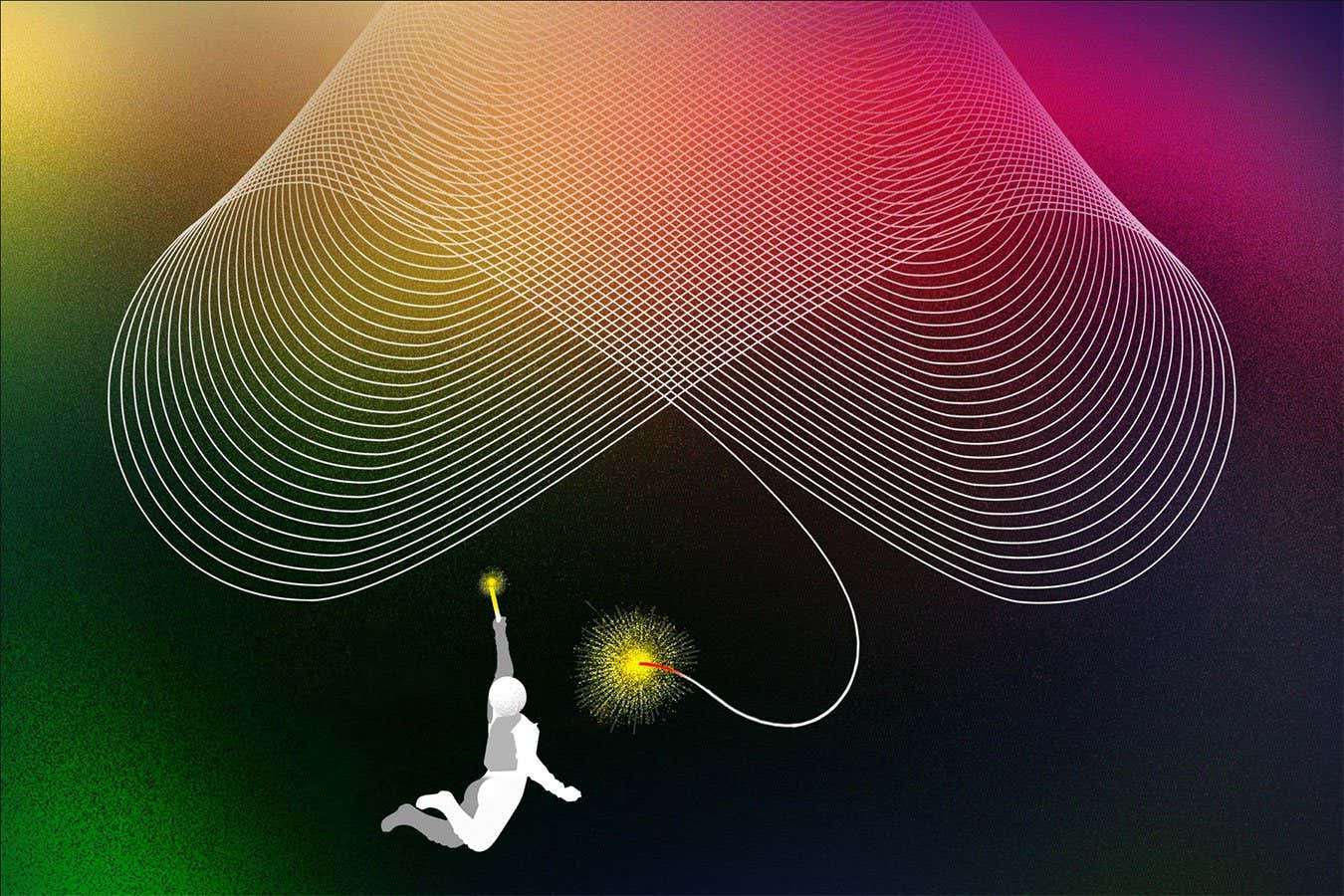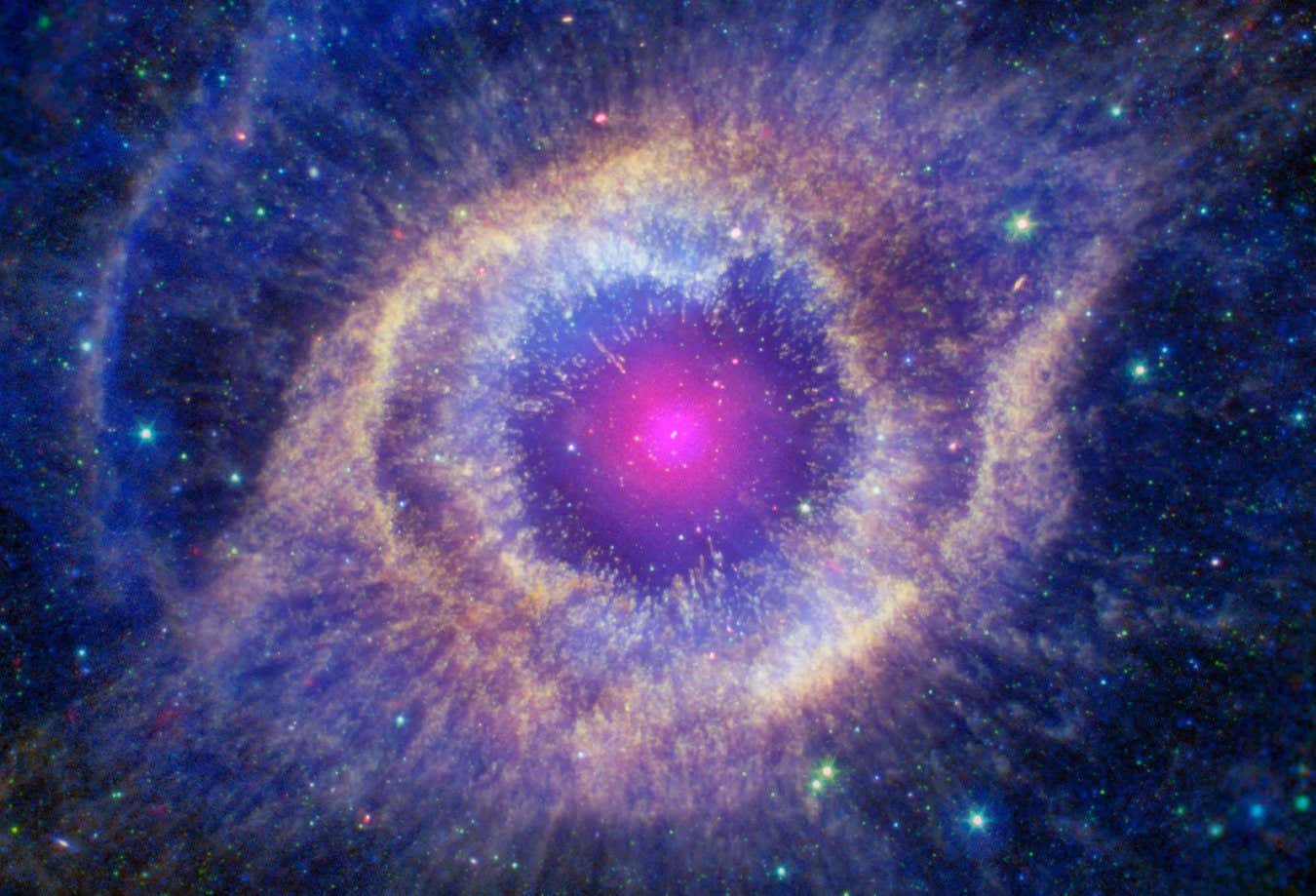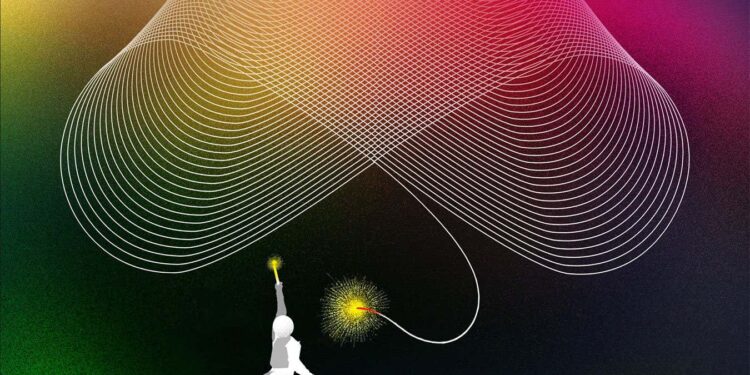
How many atoms are there in the observable universe? Current estimates point to a number we would write as 1 followed by 80 zeroes, or 1080. If you peered inside each of these atoms and counted their subatomic particles, you could count a bit higher. But what happens beyond that? Take 1090 – even if you counted every atom and subatomic particle in the known universe, you wouldn’t reach this number. In some sense, 1090 has no relation to physical reality.
But it gets worse. If 1090 invites suspicion, then what about infinity? For some people, infinity is a stand-in for a process, such as counting, that could go on forever, but doesn’t necessarily do so. For others, it means an unknowably large number. In any case, relating it to human experience becomes difficult, even if we turn to the biggest thing we know of. While the standard picture of cosmology tells us that the universe is endlessly, boundlessly infinite, we also know that it does, in some sense, have an “edge” – a bubble within the cosmos that we call the observable universe, marked out by the light that has been travelling towards us since the big bang. Anything beyond this is, effectively, unknowable.
Does this matter? Since the 1960s, a small but relentless contingent of mathematicians, philosophers, computer scientists and physicists have argued that, yes, it does. Calling themselves ultrafinitists, they warn against being overly trusting of numbers like 1090 that elude our real-world experience. And don’t even get them started on infinity. “That is just an illusion,” says Doron Zeilberger at Rutgers University, New Jersey.
Historically, the ultrafinitist movement has often been dismissed as both radical and incoherent, but its proponents say that huge numbers and infinity are undermining the foundations of science, from logic to cosmology. Now, the number of ultrafinitist sympathisers has grown large enough – though, they would be keen to stress, finitely so – that they can’t be ignored.
“There’s a critical mass now of people who have thought enough about these issues,” says Justin Clarke-Doane at Columbia University in New York. “As it stands, there’s never been a collection or canonical text written on ultrafinitism, because the problem has been seen as too hard or too radical. There’s now potential for progress.”
In April, he hosted an ultrafinitist conference at Columbia, packing a room with researchers from across different disciplines who, if not all strict adherents to the ultrafinitist creed, were at least concerned about the role that infinity plays in mathematics. “My hope is that this conference will mark a turning point in research on ultrafinitism,” Clarke-Doane said in his opening remarks. “Commentators should no longer be able to dismiss the view.”
Strong views were certainly on display. “Infinity may or may not exist, God may or may not exist, but there is no need for either in mathematics,” declared Zeilberger halfway through the first day of the conference. Most mathematicians would disagree. Modern mathematics relies on a shared framework known as Zermelo-Fraenkel set theory combined with the axiom of choice, usually abbreviated as ZFC. Essentially a list of statements that are assumed to be true, this serves as a rulebook for doing maths. One of these statements, or axioms, explicitly asserts the existence of infinity.
For most purposes, ZFC works very well – but, shockingly, a giant question mark has hung over its validity for almost a century. In 1931, mathematician Kurt Gödel showed that it is impossible to prove that the axioms of ZFC are consistent within the framework itself. “Nobody’s showed it’s inconsistent, but there’s no deep sense in which we’ll ever convince ourselves that it’s consistent,” says Clarke-Doane.
Yet this isn’t keeping many researchers up at night, as it is easy to leave ZFC operating in the background. “Nowadays, mathematicians use the ZFC theory as foundation, without necessarily embracing it explicitly,” says Zuzana Haniková at the Czech Academy of Sciences.
Numbers large and small
But 30 years after Gödel placed a bomb at the heart of mathematics, an unexpected character refused to simply wait until it exploded. Instead, Alexander Esenin-Volpin, a Russian mathematician, poet and dissident (see “The rebel mathematician”, below), claimed to have outlined a programme for proving the consistency of ZF theory. While only a subset of the ZFC rulebook, this programme still stood a chance of solidifying contemporary mathematics’ bones with an audacious trick: abandoning infinity.
Exactly how remains unclear, as Esenin-Volpin’s ideas never fully reached the mainstream of mathematical research. “These were not well-understood at the time and the details remain murky,” says Walter Dean at the University of Warwick in the UK. One contemporary review, which coined the term “ultrafinitist”, called Esenin-Volpin’s 1961 paper “not particularly convincing”.
But other mathematicians picked up the ultrafinitist torch. In 1971, Rohit Parikh at the City University of New York wrote a paper that cleared up some of the murkiness, showing that the idea of a “small number”, though hard to define precisely, can be embedded in a useful theory. He developed a mathematical theory where all numbers were kept smaller than a certain largest number, such as 2 “tetrated” to 1000, which is equal to 2 raised to the power of 2 raised to the power of 2 and so on 1000 times. While this is far larger than the 1080 atoms in the universe, it could still be deemed “feasible” within Parikh’s theory. By requiring that proofs within his framework must also be kept to a feasible length, Parikh showed that it could remain internally consistent. While unable to fully replace standard mathematics, it was the first successful attempt at a truly ultrafinitist way to do proofs.

For ultrafinitists, there is no need for infinity in mathematics
eclicktique photography/Alamy
What makes a number, or a proof, feasible? This question is at the heart of the ultrafinitist project. Though the issue connects to age-old paradoxes, such as exactly how many grains of sand you have to put together to make a pile, for Parikh, the key concern is to avoid losing track of mathematics’ connection to humanity. “You have to draw a line somewhere. Things have to be related to human activity,” he says. In his view, the ultrafinitist way of thinking orients researchers towards our experience, and he says that, while this approach is still incomplete, “an incomplete approach is better than nothing”.
Others draw inspiration from elsewhere. For Zeilberger, a computer scientist, the fact that computers can only ever approximate infinity – and so are unable to use the fuzzy “very large number” concept that humans rely on – is an argument for doing away with it. His affinity for ultrafinitism started when he first learned calculus, which uses infinitely large or small numbers rather heavily, to his distaste. The rise of calculus in the 17th century cemented infinity’s place in mathematics, but Zeilberger sees this as a historical fluke, a consequence of computers not having been developed earlier, and says that he would love to teach his students calculus without it.
Even non-ultrafinitists concern themselves with the limits of computation – indeed, there is an entire field dedicated to it, called computational complexity. Dean sees ultrafinitism and computational complexity as two sides of the same coin, one more philosophical and the other more practical.
One famous example of computational complexity theory at work is the P versus NP problem, often called the most important problem in theoretical computer science. It captures the difficulty of determining how much computational effort is required to solve certain types of mathematical problem, and whether those solutions can be easily checked.
In the 1980s, building on the work of pioneers such as Parikh, Sam Buss at the University of California, San Diego, developed “bounded arithmetic”, a set of tools for linking mathematical and computational limits when evaluating whether problems can be solved. Using these tools, he was able to identify some problems that are easy to solve and have solutions that are easy to verify. Characterising such matchups as generally as possible is at the core of what it will take to resolve the P versus NP conundrum. “This continues to be a fairly big deal and a central aim of complexity theory,” says Dean. Buss says this work has only become more important with the growth of buzzy new technologies like artificial intelligence and quantum computing, which are raising new questions about the limitations of computation.
Seen in this light, computational complexity becomes a tool for translating the rarefied realm of mathematics into physical reality, because computers are real, physical objects. Traditionally, mathematics is seen as a mere language for expressing physical truths, but some ultrafinitists go even further. For example, writing in 2013, Pavel Pudlák at the Czech Academy of Sciences argued: “One can, in principle, represent any finite mathematical structure by a physical object. Hence a theorem about finite mathematical structures is also a physical law.”
While this is a non-standard view, Clarke-Doane points out that it isn’t unreasonable. “No one has ever given an intelligible story of how to draw a sharp boundary between math and physics,” he says. “If the physical world is partly mathematical, then you have to take the math seriously in a way that you don’t when you dismiss it as a language.”
A finite universe
If the ultrafinitist project succeeds in removing infinity from our mathematical toolbox, we may then have to grapple with the possibility that the universe, even beyond the bounds of the observable universe, may actually be finite. How could the laws of physics possibly allow that? During the conference, physicist Sean Carroll at Johns Hopkins University in Maryland outlined a physical model for an ultrafinite universe.
Constructed within the framework of quantum mechanics, Carroll’s model universe is still spatially infinite, but it only has a finite number of allowable quantum states. The result is a universe that is periodic in time – it changes, but eventually always returns to its initial state. This is in stark contrast to the widely accepted view that our universe had a starting point in the big bang and, following physics laws such as those dealing with thermodynamics, continues to expand. Yet, Carroll showed that by carefully tuning his model – for instance, by limiting the ways in which the entropy, or disorder, of this universe can fluctuate – he could avoid violating those laws. In doing so, he provided a bare-bones basis for how a finite universe would work, and how the complexity of reality, such as the shape of space-time, might emerge from it.
In his presentation, Carroll didn’t argue that we live in this type of finite universe, but he didn’t fully dismiss it either, saying it was “perfectly conceivable”. And this isn’t his first attempt at examining a finite universe: previously, he and his colleagues have estimated the number of all possible quantum states in the observable cosmos to be 10 raised to the power of 10122. “None of this is definite, but it gives us licence to think finite,” said Carroll at the conference. Intriguingly, this number is derived from efforts to tie together theories of gravity and quantum mechanics, suggesting a link between ultrafinitism and the grand challenge of formulating a theory of “quantum gravity” – a definitive physics theory of everything.
Most physicists would baulk at accepting Carroll’s finite universe as a true model of reality, but the idea of destroying infinity within physics, or at least of infinity being a problem, isn’t without precedent. Take quantum field theory, which is instrumental for our current understanding of particles and forces in the universe, yet often yields infinite results. As Clarke-Doane puts it, even when physicists speak of the universe as if it were finite, “the math they’re using is up to its ears in infinity”. Physicists use a trick called renormalisation to avoid such infinities within the theory, by doing things like restricting analysis to the behaviour of a particle with a specific range of energies or velocities, rather than any possible particle.
But Tim Maudlin at New York University says this doesn’t mean there is an innate finitist tendency within quantum physics. If a calculation of the probability of two particles colliding produces an infinite number, then that calculation has simply failed, he says. Using renormalisation in this case isn’t banishing infinity, but rather finding a mathematical tool that can coax a meaningful answer from the theory. “To say you wanted a finite result isn’t because you say, ‘I reject infinite results’, but what you’re calling an infinite result just isn’t a result,” he argues. In his view, these encounters with infinity have no bearing on whether space is infinite or if there are infinitely many objects in the universe.

An ultrafinite universe might be stuck on repeat, always returning to its initial state
X-ray: NASA/CXC; Ultraviolet: NASA/JPL-Caltech/SSC; Optical: NASA/STScI(M. Meixner)/ESA/NRAO(T.A. Rector); Infrared: NASA/JPL-Caltech/K. Su
He says that to accept an ultrafinite universe, it would have to be a consequence of a new theory of physics, rather than its starting point, similar to how Albert Einstein’s theory of special relativity uncovered a finite speed of light. Without that motivation, Maudlin compares the ultrafinitist project to an author wanting to write a novel without the letter “e” – an immense technical challenge at least partly motivated by aesthetics, rather than a universal necessity.
Still, with potential benefits across a number of scientific disciplines, is it time to take ultrafinitism seriously as an alternative view of the foundations of mathematics, even if only to serve as a comparison against standard approaches? Haniková, who isn’t an ultrafinitist, thinks it could play a role here. She points to the work of the Czech mathematician Petr Vopěnka, who developed a similar alternative mathematical theory in the 1970s.
Vopěnka wondered why the infinity of mathematics can faithfully model our finite real experience. He wasn’t a strict ultrafinitist seeking to banish the infinite completely, but he still saw actual infinity as living beyond our “perceptual horizon”. He instead spoke of “natural infinity”, and developed a theory that negates the axiom of infinity that appears in standard mathematics and, to make up for it, deals with two types of mathematical objects: those that are as definite and sharply defined as usual, and some that are more “blurred”, representing a path towards some infinite horizon. This allowed Vopěnka to have a notion of infinity not just as something that is “beyond” any large collection of objects, but as something that is also somehow a part of them, says Haniková.
Could something like this reasoning be the future of ultrafinitism? Does infinity really have to go, or can mathematics be rebuilt to simply acknowledge it as something different? “This approach continues to be inspiring for mathematicians and philosophers alike,” says Haniková. For instance, it remains relevant for studies of vagueness that crop up in linguistics, ethics and mathematical logic.
Clarke-Doane is also sympathetic to the idea of encoding the vagueness of the border between the finite and the infinite into future alternative theories of mathematics’ foundations, but he concedes that ultrafinitists have a tremendous amount of work ahead of them. Even just articulating a consistent ultrafinitist theory is mostly uncharted territory.
Does this matter? “It’s very often the case that you don’t need to care for practical purposes. But sometimes you do, and if there’s no one who has a coherent philosophical story about the foundations, that’s a serious problem when things go wrong,” says Clarke-Doane. If a pipe breaks in the cellar of science, you hope that someone knows how to fix it before it becomes a flood, he says.
Ultrafinitists are on standby, building up their toolkit to prepare for philosophical emergencies.
Born in the Soviet Union in 1924, the ultrafinitist Alexander Esenin-Volpin was the son of two poets – and a rebel across the board. He completed a PhD in mathematics and was also an active translator of mathematical works from Europe, because he spoke French. But, for decades, his career as a mathematician, including the development of what would become the rejection of infinity (see main story), was put on hold in favour of protesting against the Soviet regime. More than once, he was arrested and confined to a psychiatric institution for writing and performing anti-Soviet poetry, and he organised some of the first public demonstrations against the Soviet government.
In 1972, he finally emigrated to the US and started working at Boston University. Rohit Parikh at the City University of New York, who would go on to develop Esenin-Volpin’s ideas about ultrafinitism, met him at a conference in 1975 and the Russian scholar lived with him for a month. “Unfortunately, even though I thought Volpin was a genius, I also came to realise that he didn’t quite understand his own work,” says Parikh.
But even in the face of resistance, Esenin-Volpin would stick to his assertions about infinity, often with good humour. In a 2002 lecture, logician Harvey Friedman recounted asking him about whether a series of progressively larger numbers, 21, 22, 23… 2100 are real. For the first number in the series, Esenin-Volpin “virtually immediately said yes”, but as Friedman asked about ever larger numbers, Esenin-Volpin answered with longer and longer delays. “Sure, he was prepared to always answer yes, but he was going to take 2100 times as long to answer yes to 2100 [than] he would to answering 21. There is no way that I could get very far with this,” recalled Friedman.
“A frazzled dumpling of a man… his face and body marked by the vivid traces of what the Soviet system had done to him,” as mathematician Roy Lisker described him in 1993, Esenin-Volpin died in 2016. His obituaries tended to cite his political work more than his long-lived disdain for infinity.
Topics:
Source link : https://www.newscientist.com/article/2489813-why-mathematicians-want-to-destroy-infinity-and-may-succeed/?utm_campaign=RSS%7CNSNS&utm_source=NSNS&utm_medium=RSS&utm_content=home
Author :
Publish date : 2025-08-04 16:00:00
Copyright for syndicated content belongs to the linked Source.










